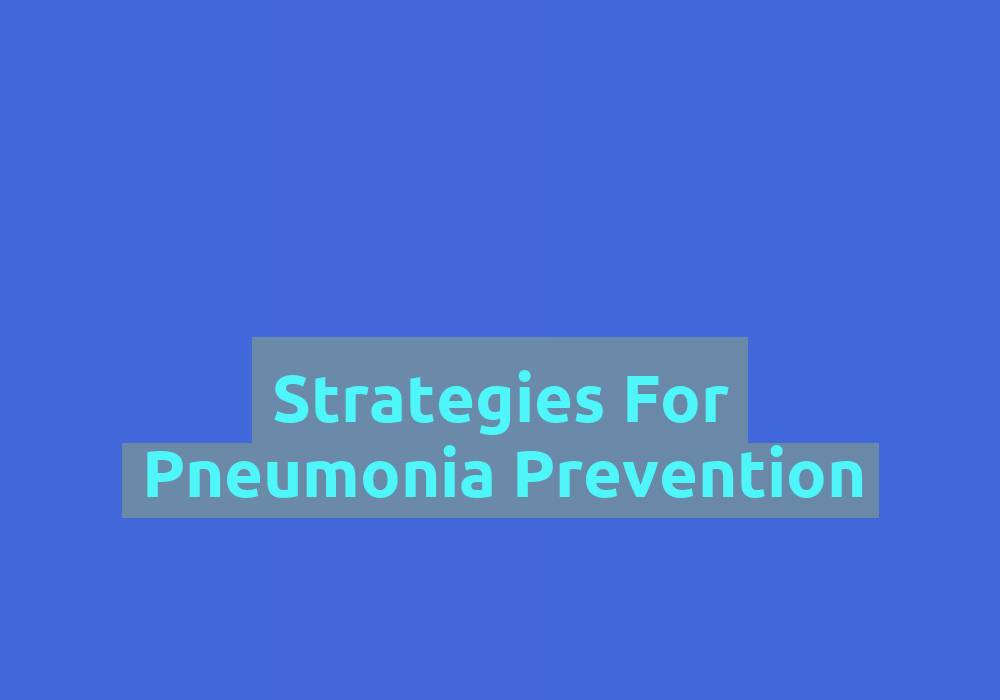Strategies for Pneumonia Prevention

Pneumonia is a serious respiratory infection that can affect people of all ages, but it is particularly dangerous for young children, older adults, and individuals with weakened immune systems. The good news is that there are several effective strategies for preventing pneumonia. By following these strategies, individuals can significantly reduce their risk of contracting this potentially life-threatening infection. In this article, we will explore some key strategies for pneumonia prevention.
1. Vaccination
Vaccination is one of the most effective ways to prevent pneumonia. Two vaccines, the pneumococcal conjugate vaccine (PCV13) and the pneumococcal polysaccharide vaccine (PPSV23), are available to protect against the most common cause of bacterial pneumonia, Streptococcus pneumoniae. These vaccines are recommended for children, older adults, and individuals with certain medical conditions.
In addition to these vaccines, it is crucial to ensure that routine vaccinations, such as the influenza vaccine, are up to date. Influenza can lead to complications, including pneumonia, especially in vulnerable populations. By getting vaccinated annually, individuals can reduce their risk of respiratory infections that can progress to pneumonia.
Some key points to consider regarding vaccination for pneumonia prevention include:
- Vaccination is particularly important for children, older adults, and individuals with certain medical conditions.
- The pneumococcal conjugate vaccine (PCV13) and the pneumococcal polysaccharide vaccine (PPSV23) are recommended to protect against Streptococcus pneumoniae, the most common cause of bacterial pneumonia.
- Routine vaccinations, such as the influenza vaccine, should also be kept up to date to reduce the risk of pneumonia.
2. Good Hygiene Practices
Practicing good hygiene is essential for preventing pneumonia. Proper handwashing is crucial in preventing the spread of respiratory infections. Individuals should wash their hands with soap and water for at least 20 seconds, especially before eating, after using the restroom, and after coming into contact with individuals who are sick.
Covering the mouth and nose with a tissue or the elbow when coughing or sneezing can help prevent the spread of respiratory droplets that may contain bacteria or viruses causing pneumonia. It is equally important to dispose of used tissues properly and to avoid close contact with individuals who are sick.
Some key points to consider regarding good hygiene practices for pneumonia prevention include:
- Proper handwashing is crucial in preventing the spread of respiratory infections. Wash hands with soap and water for at least 20 seconds.
- Cover the mouth and nose with a tissue or the elbow when coughing or sneezing to prevent the spread of respiratory droplets.
- Dispose of used tissues properly and avoid close contact with individuals who are sick.
3. Maintain a Healthy Lifestyle
Maintaining a healthy lifestyle can boost the immune system and reduce the risk of pneumonia. Here are some key aspects to consider:
a. Balanced Diet
Eating a balanced diet rich in fruits, vegetables, whole grains, and lean proteins can provide the body with essential nutrients and antioxidants needed for a healthy immune system. Including foods high in vitamins A, C, and E, as well as zinc, can specifically support respiratory health.
Some key points to consider regarding a balanced diet for pneumonia prevention include:
- A balanced diet rich in fruits, vegetables, whole grains, and lean proteins provides essential nutrients and antioxidants for a healthy immune system.
- Foods high in vitamins A, C, and E, as well as zinc, can specifically support respiratory health.
b. Regular Exercise
Engaging in regular physical activity can help maintain overall health, including a well-functioning immune system. Exercise improves blood circulation, enhances lung function, and reduces the risk of respiratory infections.
Some key points to consider regarding regular exercise for pneumonia prevention include:
- Regular physical activity helps maintain a well-functioning immune system.
- Exercise improves blood circulation, enhances lung function, and reduces the risk of respiratory infections.
c. Adequate Sleep
Getting enough restorative sleep is vital for a healthy immune system. Lack of sleep can weaken the body’s defenses, making it more susceptible to infections, including pneumonia. Aim for 7-8 hours of quality sleep each night.
Some key points to consider regarding adequate sleep for pneumonia prevention include:
- Adequate sleep is vital for a healthy immune system.
- Lack of sleep weakens the body’s defenses, increasing the susceptibility to infections, including pneumonia. Aim for 7-8 hours of quality sleep each night.
d. Avoid Smoking and Excessive Alcohol Consumption
Smoking damages the lungs and weakens the immune system, making individuals more susceptible to respiratory infections. Avoiding smoking and secondhand smoke is crucial for pneumonia prevention. Excessive alcohol consumption can also impair the immune system, so it is advisable to drink in moderation or avoid alcohol altogether.
Some key points to consider regarding avoiding smoking and excessive alcohol consumption for pneumonia prevention include:
- Smoking damages the lungs and weakens the immune system, increasing the susceptibility to respiratory infections, including pneumonia.
- Avoiding smoking and secondhand smoke is crucial for pneumonia prevention.
- Excessive alcohol consumption can impair the immune system, so it is advisable to drink in moderation or avoid alcohol altogether.
4. Environmental Precautions
Taking precautions in the environment can help prevent pneumonia. Here are some important recommendations:
a. Avoid Exposure to Air Pollution
Exposure to air pollution, such as smoke, chemicals, and particulate matter, can irritate the lungs and increase the risk of respiratory infections. It is advisable to limit exposure to polluted air by staying indoors on days with poor air quality and avoiding areas with heavy smoke or pollution.
Some key points to consider regarding avoiding exposure to air pollution for pneumonia prevention include:
- Exposure to air pollution can irritate the lungs and increase the risk of respiratory infections, including pneumonia.
- Limit exposure to polluted air by staying indoors on days with poor air quality and avoiding areas with heavy smoke or pollution.
b. Maintain Clean Indoor Spaces
Regularly cleaning and ventilating indoor spaces can reduce the presence of bacteria and viruses that can cause pneumonia. Pay particular attention to commonly touched surfaces, such as doorknobs, light switches, and remote controls.
Some key points to consider regarding maintaining clean indoor spaces for pneumonia prevention include:
- Regularly cleaning and ventilating indoor spaces helps reduce the presence of bacteria and viruses that can cause pneumonia.
- Pay particular attention to commonly touched surfaces, such as doorknobs, light switches, and remote controls.
c. Humidify Dry Environments
Dry air can make individuals more susceptible to respiratory infections. Using a humidifier can help maintain optimal humidity levels, especially during the winter months when indoor heating systems tend to dry out the air.
Some key points to consider regarding humidifying dry environments for pneumonia prevention include:
- Dry air can increase the susceptibility to respiratory infections, including pneumonia.
- Using a humidifier can help maintain optimal humidity levels, especially during the winter months when indoor heating systems tend to dry out the air.
5. Managing Underlying Health Conditions
Certain underlying health conditions can increase the risk of developing pneumonia. It is important for individuals with these conditions to manage them effectively and follow their healthcare provider’s recommendations. Conditions such as asthma, chronic obstructive pulmonary disease (COPD), diabetes, and heart disease can weaken the immune system and impair respiratory function, making individuals more vulnerable to pneumonia.
Some key points to consider regarding managing underlying health conditions for pneumonia prevention include:
- Individuals with underlying health conditions such as asthma, COPD, diabetes, and heart disease are more vulnerable to pneumonia.
- It is important to manage these conditions effectively and follow healthcare provider’s recommendations.
- Regular check-ups, following prescribed treatments, and adopting a healthy lifestyle can help individuals manage their underlying health conditions effectively and reduce the risk of pneumonia.
In conclusion, pneumonia prevention is crucial for individuals of all ages, especially those who are more susceptible to respiratory infections. By following these strategies, including vaccination, practicing good hygiene, maintaining a healthy lifestyle, taking environmental precautions, and managing underlying health conditions, individuals can significantly reduce their risk of contracting pneumonia. Remember, prevention is always better than cure when it comes to this potentially serious infection.
FAQ
Q: Who is at higher risk of contracting pneumonia?
A: Young children, older adults, and individuals with weakened immune systems are particularly at higher risk of contracting pneumonia.
Q: What are the recommended vaccines for pneumonia prevention?
A: The pneumococcal conjugate vaccine (PCV13) and the pneumococcal polysaccharide vaccine (PPSV23) are recommended to protect against Streptococcus pneumoniae, the most common cause of bacterial pneumonia.
Q: How can good hygiene practices help prevent pneumonia?
A: Proper handwashing, covering the mouth and nose while coughing or sneezing, disposing of used tissues properly, and avoiding close contact with sick individuals can help prevent the spread of respiratory droplets that may contain bacteria or viruses causing pneumonia.
Q: How can a healthy lifestyle reduce the risk of pneumonia?
A: A balanced diet rich in fruits, vegetables, whole grains, and lean proteins, regular exercise, adequate sleep, avoiding smoking and excessive alcohol consumption can boost the immune system and reduce the risk of pneumonia.

